Aye Myat Thu: ‘She Just Fell Down. And She Died.’

By Hannah Beech/New York Times
Myanmar’s security forces have killed more than 40 children since February. Here is the story of one, Aye Myat Thu. She was 10.
In the swelter of the hot season, U Soe Oo cracked open the coconut with practiced blows of his machete. Small hands reached out for the first slice, cool and slippery.
His daughter — 10 years old, with dreams of being a makeup artist or a nurse or maybe even a princess with long golden hair like the one in “Maleficent,” which she had watched a zillion times, no joke — ran down a path with her sweet prize.
Just as she reached the trees that marked the perimeter of their property, the girl seemed to stumble, landing flat on her stomach, her father recalled. The piece of coconut slipped from her grasp, falling onto the reddish earth of Mawlamyine, a port town perched on a slender archipelago in southeastern Myanmar.
Mr. Soe Oo put his machete down and ran to tell her it was OK, that she could have another chunk of coconut. He scooped her up, limp in his arms, but it still didn’t register where all the blood was coming from, why she wasn’t saying anything at all.
The bullet had hit the left temple of his daughter, Aye Myat Thu, at about 5:30 in the soft glow of the afternoon of March 27. By the time darkness fell less than an hour later, she was dead.
Since staging a Feb. 1 coup and jailing the nation’s civilian leaders, the Myanmar military, known as the Tatmadaw, has murdered, assaulted and arrested with impunity. More than 550 people have been killed on the streets and in their homes by soldiers or police officers, according to a monitoring group.
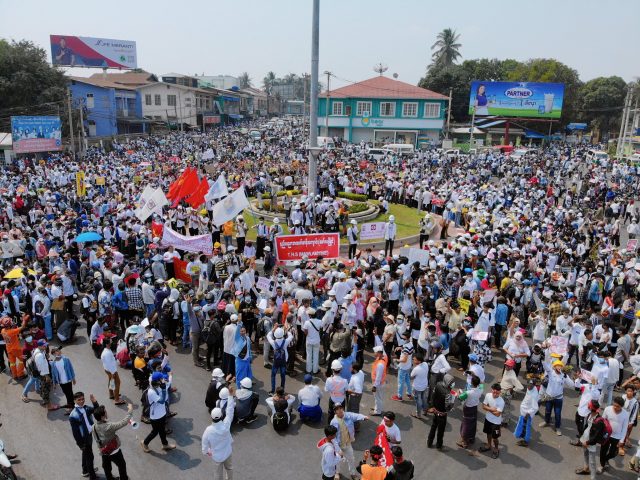
A February protest in Mawlamyine, Myanmar, where Aye Myat Thu and her family lived.Credit…Kaung Khant Soe
At least 40 of the dead were children under 18, according to a tally compiled by The New York Times that relies on medical testimony, funeral details and family accounts. A few of the minors were killed for participating in the protests. Many others were bystanders who were seemingly executed, with a single gunshot to the head.
Often the children were killed as they went about their lives, playing or huddling with their families, in cities and towns that have descended into terror. Some had done nothing more threatening in their final moments than seek the comfort of a father’s lap, serve tea, fetch water or run down a lane with a piece of coconut.
“I have no power of revenge against the soldiers who killed my daughter,” said Daw Toe Toe Lwin, Aye Myat Thu’s mother. “All I can do is hope their turn comes soon.”
The slaughter of children has eclipsed the violence of previous military crackdowns, horrifying a nation accustomed to the Tatmadaw’s impulse to use maximum force against peaceful civilians. And it has hardened the resolve of a mass protest and civil disobedience movement that shows little sign of folding in the face of army snipers and grenade launchers.
This past week, a United Nations special envoy for Myanmar warned the Security Council that “a blood bath is imminent” and that “the whole country is on the verge of spiraling into a failed state.”
In Mawlamyine — known for its Buddhist pagodas and fleeting mentions, by its old name of Moulmein, in a Rudyard Kipling poem and a George Orwell essay — the protests began a week after the coup. They have coalesced almost daily since, with protesters occasionally showing up on boats in the harbor or on fleets of motorcycles.
Members of Aye Myat Thu’s family had not been politically active. Four years ago, when others in Mawlamyine protested the naming of a bridge after a general from another state, they kept quiet. A decade before that, when monks led protests against the military junta, they also stayed home. The same was true in 1988, when Myanmar erupted in pro-democracy dissent, only for the military to gun down thousands of people nationwide.
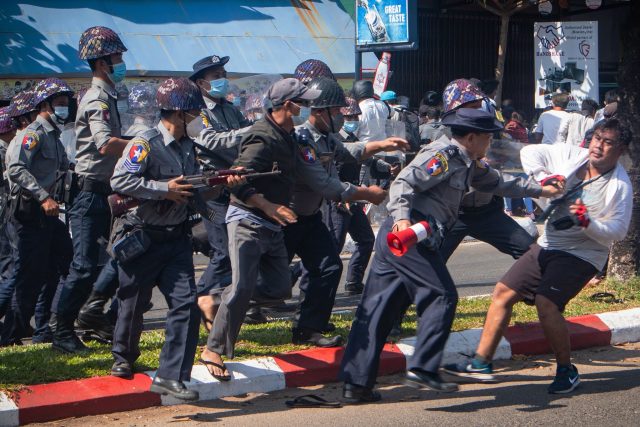
An arrest outside Mawlamyine University in February, during a protest against the military coup.Credit…EPA, via Shutterstock
This time was different. Mr. Soe Oo is a furniture polisher. His two oldest daughters — Aye Myat Thu was the fourth of five — are a teacher and a beauty salon owner. There was a sense of upward mobility in a country once trapped by an economically disastrous mix of socialism and numerology, which gave preferential treatment to a former junta chief’s favorite digit. (At one point, when currency notes in multiples of nine replaced conventional ones, some of Myanmar’s savings evaporated.)
Today, the family is neither rich nor poor. But they are clear beneficiaries of the political and economic reforms that began a decade ago, which allowed ordinary citizens to buy cellphones, join Facebook and set up private savings accounts safe from government hands.
The family acquired some of the trappings of middle-class success, including a sound system and a television. Aye Myat Thu used her allowance to buy a bicycle with a blue basket. She discovered TikTok, along with the pleasures of a princess filter with tiaras and pink hearts. She and her sisters would dance with a frenetic jumble of limbs, before erupting in laughs so consuming that they had to stop the video.
For the first time, perhaps, the family had something to lose. Aye Myat Thu’s aunt marched in the anti-coup protests for “the revolution.”
Her niece was full of questions.
“She asked me once what people are doing out on the street, because she saw on Facebook that people are protesting and dying,” said her aunt, Daw Kyu Kyu Lwin. “I explained to her about the coup and why we were protesting. She said nothing but listened as I explained. She was thinking.”
On March 20, with the death toll mounting, some residents of Mawlamyine staged a set of creative rallies, meant to keep them safe. Instead of protesting in person, they lined up rows of stuffed animals, posting photos of them on social media. There were Winnie the Poohs and Piglets, the Japanese robot cat Doraemon and a tiny turtle holding a sign that read, “We want democracy.”
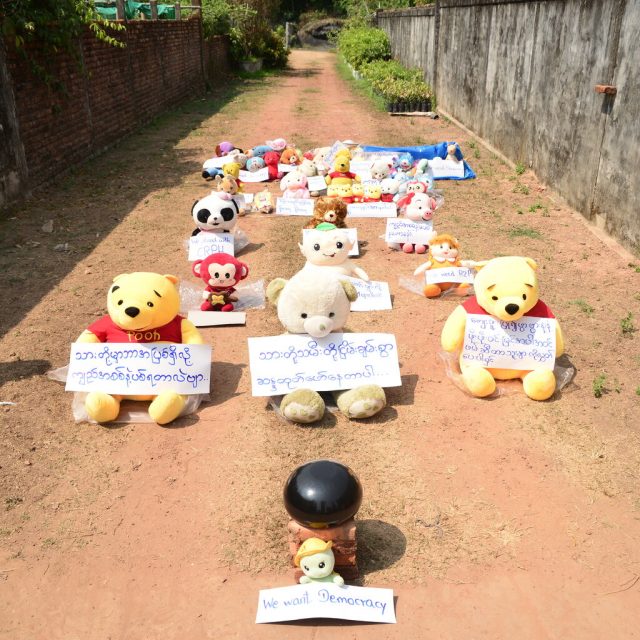
A social-media demonstration in Mawlamyine last month.Credit…Hla Myo Oo
A week later, the mercury rose in Mawlamyine. Tarmac roads shimmered. A hot wind wafted from the Andaman Sea. It was Armed Forces Day in Myanmar, and Senior Gen. Min Aung Hlaing, the army chief and coup instigator, presided over a display of Tatmadaw weaponry in the capital, Naypyidaw.
Across the country that day, the security forces shot dead at least 114 people, among them seven children. In Yangon, the largest city in Myanmar, a baby girl was half-blinded when a rubber bullet struck her eye.
In Mawlamyine this time, the protesters did not rely on stuffed toys as stand-ins. About 300 people gathered in the unrelenting sun, behind sandbag barricades. Some wore plastic helmets as they faced off with about 100 members of the security forces. The bullets started out as rubber and by afternoon had hardened to live fire. Protesters scattered, but two were killed.
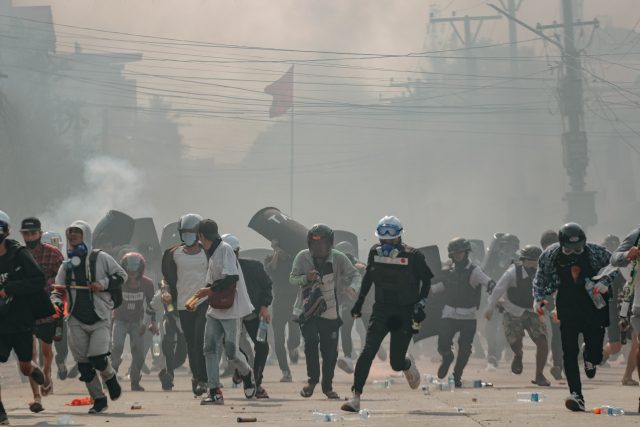
Protesters in Mawlamyine on March 27, the day Aye Myat Thu was killed.Credit…Kaung Myat Lin
No one quite knew why the soldiers wandered into Aye Myat Thu’s neighborhood of neat wooden houses, each painted a cheerful hue, sprays of bougainvillea adding more splashes of color.
Mr. Soe Oo took a coconut from the family palm tree and hacked at it carefully, lest the sweet water spill out. Sounds like the pop of firecrackers echoed in the hazy heat.
Aye Myat Thu grabbed her slice of coconut. The popping noises drew her down the path from her house. Past the trees, a camouflaged presence stalked, according to other neighborhood residents. No one in the family saw him.
The hole from the bullet was so small that Mr. Soe Oo said he couldn’t understand how it had extinguished the life of his daughter, another random victim of a trigger-happy military.
“She just fell down,” he said. “And she died.”
The funeral was the next day. Buddhist monks chanted, and mourners gathered around the coffin, raising their hands in the three-fingered salute from “The Hunger Games” that has become the protesters’ symbol of defiance. Garlands of jasmine framed the girl’s face, the bullet still lodged somewhere in her skull.
“I want to tear off the soldier’s skin as revenge,” said U Thein Nyunt, her uncle. “She was just an innocent child with a kind heart. She was our angel.”
Around her body, the family placed some of Aye Myat Thu’s favorite belongings: a set of crayons, a few dolls and a purple rabbit, some Fair and Lovely cream, a Monopoly board and a drawing of Hello Kitty she had sketched two days before she was killed. On the paper, next to the cartoon cat, Aye Myat Thu had written out her name in careful English letters.
“I feel empty,” said Ms. Toe Toe Lwin, her mother.
Right after the funeral, Aye Myat Thu was cremated, the flames burning her treasures with her. In other parts of the country, soldiers have stolen corpses of those they killed, perhaps to conceal the evidence of their brutality. In one case, they exhumed a child’s grave.
The family didn’t want the same for their little girl.
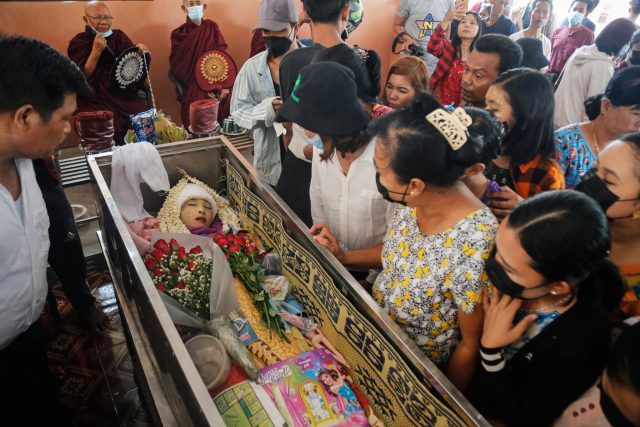
Aye Myat Thu’s funeral. Her family placed some of her favorite possessions alongside her.Credit…Than Lwin Times
Original Post: The New York Times

